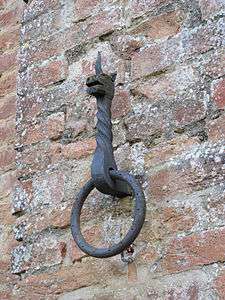Ferro-actinolite
Ferro-actinolite is the ferrous iron rich endmember of the actinolite - tremolite continuous solid solution series of the double chain calcic amphibole group of inosilicate minerals. All the series members belong to the monoclinic crystal system.
The following formula comparison indicates the position of individual well-known members within the series:
Some other substitute cations that may replace either Ca, Mg, or Fe include potassium (K), aluminium (Al), manganese (Mn), titanium (Ti), and chromium (Cr). A fluorine (F) anion may partially replace the hydroxyl (OH).
Physical properties
Ferroactinolite prisms are much darker in color than actinolite due to higher iron content affecting opacity, but may be dark green in thin slices or around the edges. The crystals are brittle with a hardness of 5-6 on the Mohs scale and a white streak. It is pleochroic and has a higher refractive indices and surface relief than actinolite.
References
Ferro
Ferro may refer to:

Ferro (architecture)
A ferro (plural ferri) or ferro da facciata is an item of functional wrought-iron work on the façade of an Italian building. Ferri are a common feature of Medieval and Renaissance architecture in Lazio, Tuscany and Umbria. They are of three main types: ferri da cavallo have a ring for tethering horses, and are set at about 1.5 metres from the ground; holders for standards and torches are placed higher on the façade and on the corners of the building; arpioni have a cup-shaped hook or hooks to support cloth for shade or to be dried, and are set near balconies.
In Florence, ferri da cavallo and arpioni were often made to resemble the head of a lion, the symbolic marzocco of the Republic of Florence. Later, cats, dragons, horses and fantastic animals were also represented.

Bargello, Florence
Bargello, Florence

Ferro from two ages, Palazzo degli Altoviti, Florence
Ferro from two ages, Palazzo degli Altoviti, Florence
Ferro (surname)
Ferro is an Italian and Spanish surname related to the word ferro ("iron").People with this surname include:
Podcasts:


